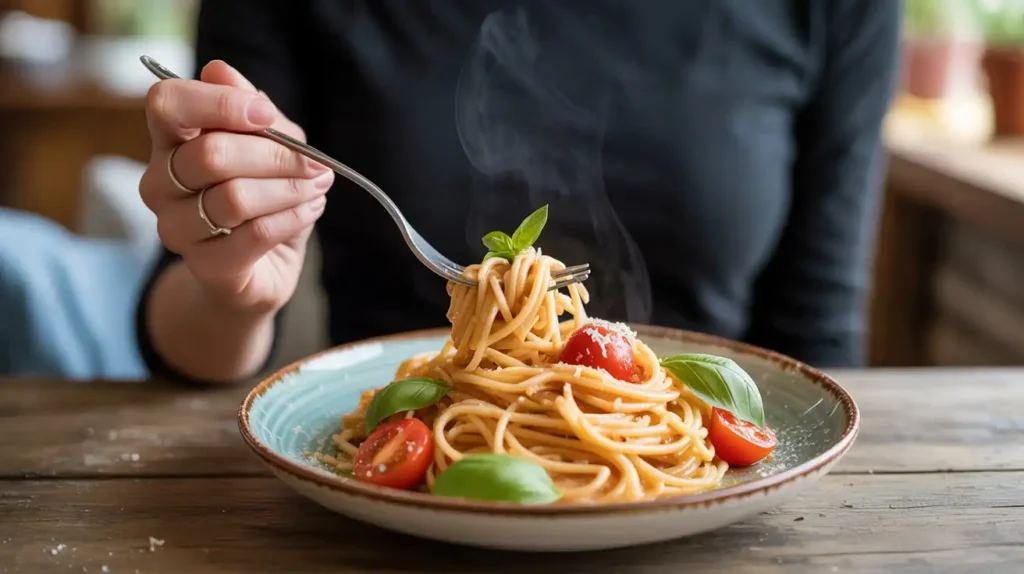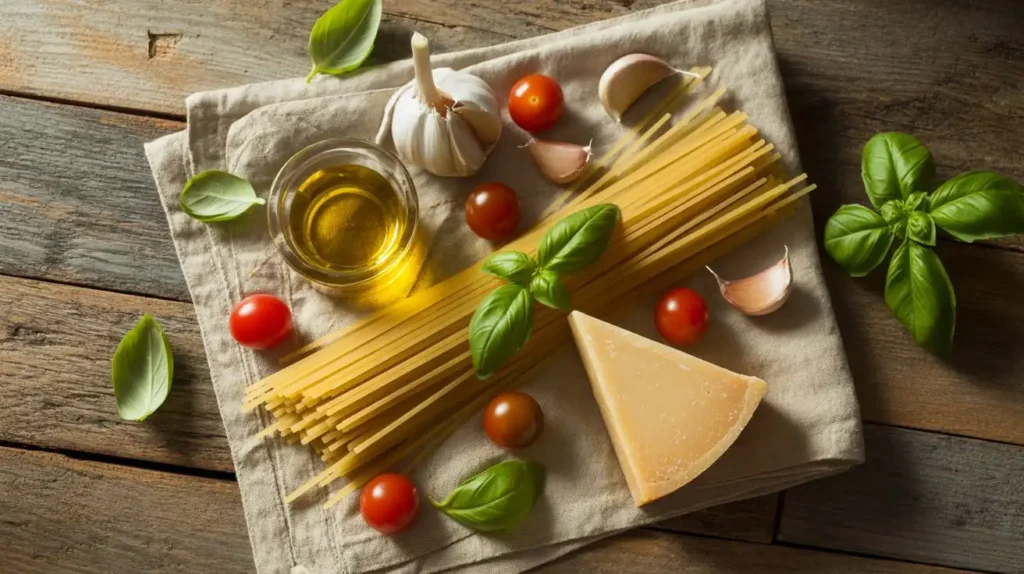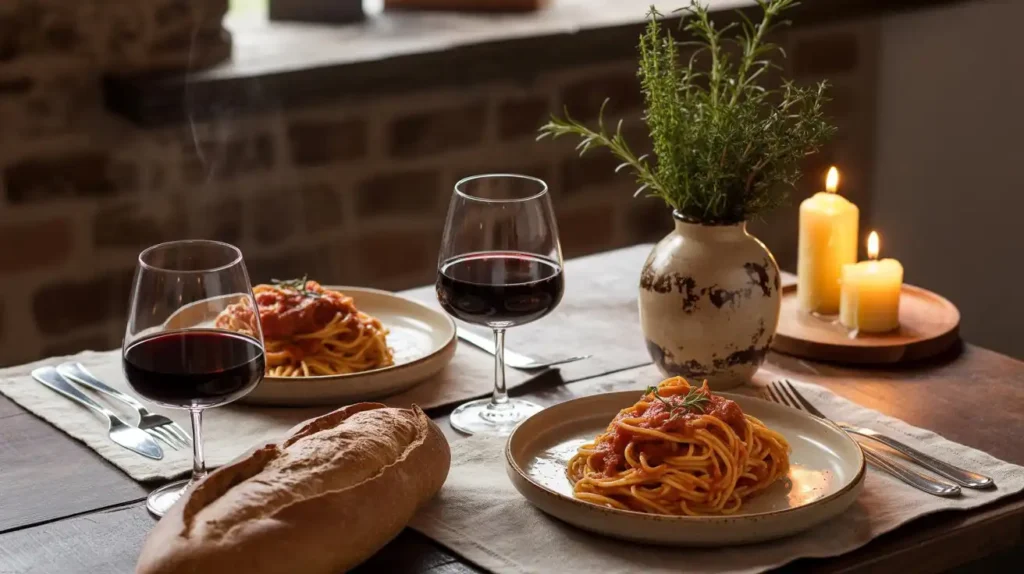The Everyday Charm of Simple Pasta Dishes
There’s something quietly comforting about simple pasta dishes. Maybe it’s the way a warm bowl can ease a long day, or the nostalgic kick of that first bite that reminds you of college nights, quick fixes, or even your first solo attempt at “real” cooking. In many American and European homes, these dishes have become more than just dinner — they’re a ritual, a fallback, a canvas for creativity.
The roots of pasta go deep into Italian soil, of course. But over time, the West gave it a remix. From creamy Alfredo to one-pot tomato basil pasta, the American take on simple pasta dishes is all about practicality without sacrificing flavor. And that’s exactly why they’ve carved such a strong presence in family kitchens and trendy bistros alike. They’re fast, flexible, and frankly, forgiving — which is more than you can say about most weeknight meals.
Personally, I stumbled into the world of pasta on a rainy Tuesday, broke and hungry, armed with just spaghetti, garlic, and hope. The result wasn’t perfect — but it was mine. That’s the beauty of simple pasta dishes: they welcome experimentation and grow with you. Whether you’re cooking for one, feeding a family, or impressing a guest on short notice, they show up and deliver.
In this article, we’ll walk step-by-step through a flavorful, foolproof pasta recipe. We’ll talk ingredients, offer substitutions (gluten-free? vegan? got you covered), and troubleshoot common kitchen hiccups. By the end, you’ll not only have a go-to recipe — you’ll know how to own it.
Essential Ingredients for Making a Flavorful Simple Pasta Recipe
Let’s be honest: the appeal of simple pasta dishes isn’t just in the ease — it’s in the freedom. You don’t need a culinary degree or a specialty store; you just need a few good ingredients and the willingness to improvise a little. That’s part of the charm, isn’t it?
Below is what I typically use for a basic, flavor-packed pasta that works any night of the week. But I’ll also walk you through substitutions — because we all know the fridge doesn’t always cooperate.
What You’ll Need for Simple Pasta Dishes
- 12 oz pasta – spaghetti, penne, or fusilli all work (use what’s in your pantry)
- 2 tablespoons olive oil – extra virgin if you’ve got it; otherwise, don’t stress it
- 3 garlic cloves, minced – fresh is best, but pre-minced from a jar? Been there
- 2 cups cherry tomatoes, halved – or whatever small tomatoes you can find
- A handful of fresh basil – roughly chopped (if it’s wilting, it’s still fine)
- Salt and black pepper – to taste (don’t under-season — it makes a difference)
- Pinch of red pepper flakes – totally optional, but adds a subtle kick
- ½ cup grated Parmesan – or more if you’re feeling generous
- ½ cup pasta water – save this before draining; it’s liquid gold
Simple Pasta Dish Swaps & Tweaks (Real-Life Tested)
- No gluten? Use rice-based or chickpea pasta. They hold up better than you’d think.
- Dairy-free or vegan? Ditch the Parmesan and try nutritional yeast or a cashew-based sprinkle. Or honestly, just go without — the tomatoes and garlic can carry the flavor.
- Low on tomatoes? A spoonful of tomato paste with a splash of water can do the job in a pinch. It won’t be quite the same, but it’s solid.
- Fresh herbs MIA? You can get away with a sprinkle of dried oregano or thyme, but add it earlier in the cooking so it softens and melds.
What Actually Matters in Simple Pasta Dishes
If I had to boil it down (no pun intended), I’d say this: what matters most in simple pasta dishes is balance. Good salt, enough fat (olive oil), and a little acidity from tomatoes — or even a squeeze of lemon — make up the trifecta. Everything else? Totally customizable.
Out of Basil in Your Simple Pasta Dish? Here’s What to Do
Not necessarily. If you’ve got parsley, arugula, or even a few spinach leaves, give them a quick chop and toss them in at the end. It won’t taste exactly the same, but you’ll still get that fresh, green note.

Step-by-Step Instructions to Make This Simple Pasta Dish Easily
This isn’t one of those “blink and it’s done” recipes — but it fits right in with the best simple pasta dishes. Once you’ve made it once or twice, it becomes second nature. No fancy tools, no rigid rules. Just you, a pan, and a few solid ingredients doing their thing.
Here’s how I make it — and how you can, too.
Step 1: Boil the Pasta for Your Simple Pasta Dish
- Bring a large pot of salted water to a boil.
(Pro tip: make the water taste like the sea. It’s your only shot to season the pasta itself.) - Add pasta and cook according to the package, minus 1 minute. You want it just shy of al dente — it’ll finish in the pan.
- Before draining, scoop out about ½ cup of the pasta water and set it aside. Then drain and let it sit for a second.
Step 2: Sauté the Garlic to Build Flavor in Your Simple Pasta Dish
- While the pasta boils, heat the olive oil in a large skillet over medium heat.
- Add the minced garlic and stir constantly for about 30 seconds — no more.
(Seriously, garlic goes from golden to bitter fast. Don’t look away.) - If you like a little heat, toss in the red pepper flakes now.
Step 3: Incorporate Juicy Fresh Tomatoes to Create a Delicious, Slow-Simmered Pasta Sauce
- Add the halved cherry tomatoes to the pan.
- Let them cook down for 5–7 minutes, stirring occasionally, until they start to soften and release their juices.
(You’ll know it’s right when the pan looks juicy but not soupy.)
Step 4: Toss Pasta and Fresh Tomato Sauce Together for a Perfectly Coated, Delicious Meal
- Add the drained pasta directly into the skillet with the tomato mixture.
- Pour in a splash of that reserved pasta water (start with a couple tablespoons).
- Toss gently, letting the pasta soak up the flavor and finish cooking — about 1–2 minutes.
- Sprinkle in the grated Parmesan and stir again until glossy and creamy.
Step 5: Garnish and Serve Your Flavorful Pasta with Fresh Herbs, Parmesan Cheese, and Olive Oil
- Turn off the heat.
- Tear or chop the fresh basil and add it in.
- Taste. Add more salt, pepper, or cheese if needed.
- Plate it up — maybe drizzle a little more olive oil on top for shine.
H3: How to Fix Dry or Clumpy Pasta for a Creamy, Perfectly Sauced Dish
Add a little more pasta water — just a tablespoon at a time — and toss until you hit that silky sweet spot. Don’t overdo it, or you’ll end up with soup instead of sauce.

Tips & Variations: Easy Pasta Recipe Hacks and Flavor Boosters to Make It Your Own
Here’s the real secret behind simple pasta dishes: they’re more suggestion than script. Once you’ve nailed the basics, you can riff endlessly. Some nights you’re craving richness; others, you want something clean and bright. This dish flexes with you.
Below are some real-world, tested tweaks — the kind you figure out after making it a dozen different ways (and maybe burning the garlic once or twice).
Flavor Boosters You’ll Love to Add for a Tastier, More Delicious Pasta
- Add a protein: Grilled chicken, shrimp, or even a soft-boiled egg make it more filling without overcomplicating things.
- Toss in greens: Spinach, arugula, or kale wilt down beautifully in the final minute of cooking.
- Craving umami? A few chopped sun-dried tomatoes, a spoonful of olive tapenade, or even a dash of anchovy paste (don’t knock it) can add depth.
- Want it creamy? Stir in a spoonful of ricotta or mascarpone at the end. It softens everything and adds a luxe touch.
Easy Dietary Variations for Gluten-Free, Vegan, and Dairy-Free Pasta Dishes
- Vegan: Ditch the Parmesan. Add extra basil, nutritional yeast, or a bit of miso paste to bring the savoriness back.
- Gluten-free: Sub in lentil or chickpea pasta — they’re surprisingly satisfying and add a little extra protein.
- Low-carb: Try zucchini noodles (zoodles), but cook them separately and add at the end to keep texture on point.
- Dairy-free: Go light on cheese or skip it — just boost the seasoning and maybe drizzle a touch more olive oil for balance.
Tips to Plate and Present Your Pasta Dish Beautifully Every Time
- Use tongs to twist the pasta into a tall little mound — it looks more “restaurant” that way.
- Top with fresh basil leaves and a final shaving of cheese.
- Add a grind of black pepper or a drizzle of chili oil for extra drama.
Easy Tips to Elevate Your Pasta Dish for a Fancy Dinner
Yes — and it doesn’t take much. Plate it in shallow bowls, light a candle, add a glass of wine (or even sparkling water with lemon). Nobody needs to know it took 20 minutes.

Nutrition Facts and Health Benefits of Your Homemade Pasta Recipe
Okay, so let’s talk numbers — not to ruin the magic of pasta night, but to give you a clearer picture of what you’re actually eating. While this dish is simple, it’s surprisingly well-rounded in terms of nutrients. Plus, it’s easy to adjust if you’re watching your intake for any reason.
Here’s the estimated nutritional breakdown per serving (about 1½ cups), assuming you follow the base recipe without extra cheese, cream, or added protein:
Calories and Macronutrients Per Serving for Your Pasta Dish
- Calories: ~420
- Total Fat: 14g
- Saturated Fat: 3.5g
- Carbohydrates: 58g
- Fiber: 4g
- Sugars: 6g (mostly from the tomatoes)
- Protein: 13g
- Sodium: ~310mg
- Vitamin C: ~20% Daily Value
- Calcium: ~15% DV
- Iron: ~10% DV
What Your Pasta Nutrition Numbers Really Mean for Your Health
For starters, this meal gives you a solid blend of macronutrients — carbs for energy, healthy fats from the olive oil, and just enough protein to satisfy. In addition, the tomatoes and fresh herbs bring in a boost of antioxidants and vitamins.
If you’re eating vegetarian, you’ll appreciate that this pasta doesn’t rely on meat for its protein. Instead, Parmesan and the pasta itself (especially if you choose whole wheat or legume-based noodles) do a lot of the heavy lifting.
On the other hand, if you’re trying to cut calories or reduce fat, it’s easy to lighten things up. For example, use less cheese or go with a lower-fat alternative. Similarly, you can bulk it up with greens to increase fiber without drastically changing the taste or feel.
As a result, this dish isn’t just comfort food — it’s also flexible. Whether you’re tracking macros or just trying to eat more whole foods, it fits.
Is This Simple Pasta Dish Healthy? Nutrition and Dietary Insights
It depends on your goals. If you’re eating clean and aiming for balanced meals, then yes — this dish can absolutely work. However, it’s not meant to be ultra-low-carb or keto. Think of it as wholesome, customizable, and satisfying… not restrictive.
Common Problems & Fixes – When Things Don’t Go Perfectly
Let’s not pretend every kitchen session ends like a food blog photo shoot. Sometimes things just go sideways — the garlic burns, the pasta clumps, or the sauce dries out before you can say “al dente.” Fortunately, most of these common mishaps are fixable — fast.
Here’s what tends to go wrong and exactly how to get your dish back on track.
Problem 1: Why Did My Pasta Turn Mushy and How to Fix It
Why it happens:
You probably cooked it too long or didn’t drain it fast enough. Pasta keeps cooking even after you pull it from the water, especially if you leave it sitting in the pot.
Quick Fix:
Next time, undercook it slightly (about 1 minute shy of package directions) and finish cooking it in the sauce. That final step helps the texture hold and the flavors bind. If it’s already mushy, try tossing in some toasted breadcrumbs or chopped nuts to add crunch.
Problem 2: How to Fix Dry or Sticky Pasta Sauce for a Perfect Texture
Why it happens:
You may have skipped the pasta water — or added it too late. That water contains starch, which binds the oil, cheese, and tomato juices into a silky coating.
Quick Fix:
Add a splash (just a tablespoon or two) of warm water and stir over low heat. You can also drizzle a bit more olive oil or stir in a knob of butter for instant recovery.
Problem 3: How to Fix Bland Pasta Flavor and Boost Taste
Why it happens:
Not enough salt. Either in the pasta water, the sauce, or both. And sometimes, tomatoes need a little sugar or acid (like lemon juice) to balance their flavor.
Quick Fix:
First, check your salt. Then, add a pinch of sugar or a squeeze of lemon to brighten everything. A final sprinkle of cheese or a grind of black pepper also helps bring things together.
How to Rescue and Improve a Pasta Dish That Tastes “Meh”
Yes — most of the time. A finishing touch like fresh herbs, extra cheese, chili oil, or a drizzle of lemon juice can lift a flat dish. Even just letting it rest a minute before serving helps the flavors settle and meld.
Simple Pasta Dishes FAQ: Common Questions and Expert Answers
Can I Substitute Different Types of Pasta in This Recipe?
Absolutely. This dish plays well with just about any shape — spaghetti, rigatoni, farfalle, fusilli — you name it. Short pasta like penne holds the sauce well, while long noodles like linguine offer a slurpier vibe. Just keep an eye on the cook time and salt the water generously. If you’re using gluten-free or legume-based pasta, note that the texture can be slightly different — firmer or more delicate — so taste as you go.
Can I Prep This Simple Pasta Recipe Ahead of Time?
Yes, with a few caveats. You can absolutely make the sauce in advance — it keeps well in the fridge for up to 3 days. However, pasta is best cooked fresh if you want the texture just right. If you’re short on time, boil the pasta ahead and toss it in a little olive oil to prevent sticking. Then reheat everything together with a splash of water or broth before serving.
What’s the Best Way to Store Leftover Pasta for Freshness?
Store the pasta in an airtight container in the fridge for up to 3 days. When reheating, add a tablespoon of water or olive oil to loosen things up — pasta loves to soak up sauce when it sits. For best results, reheat on the stove over low heat instead of the microwave (but let’s be real, microwave works fine when you’re hungry).
Can You Freeze Simple Pasta Dishes? Tips and Best Practices
Technically, yes — but honestly, it’s not ideal. The texture of the pasta may suffer, and the fresh herbs can turn limp. If you do freeze it, let it cool fully first, portion it out, and use within a month. Just don’t expect restaurant-quality results after thawing.
Conclusion: Make This Simple Pasta Recipe Your Own and Enjoy
At the end of the day, simple pasta dishes like this aren’t just about getting dinner on the table. They’re about carving out a moment of calm, creativity, or connection — even if it’s just with yourself. That’s what makes them special.
This recipe isn’t meant to impress a crowd (though it might). It’s meant to work — reliably, flexibly, and with whatever you’ve got on hand. It’s the kind of dish that forgives a little overcooked garlic or missing basil. And sometimes, that’s exactly the kind of recipe we need.
If you try it, I’d love to hear how it turned out — what you added, skipped, or discovered along the way. Drop a comment, leave a rating, or share your own spin. This dish is yours now. Own it.
👉 Looking for more pasta inspiration? You might enjoy:
- Quick Vegetarian Lunches – Easy and Delicious Step-by-Step Guide
- Easy Stir-Fry Meals – A Simple and Delicious Step-by-Step Guide
Thanks for reading — now go make something simple, satisfying, and totally yours.

